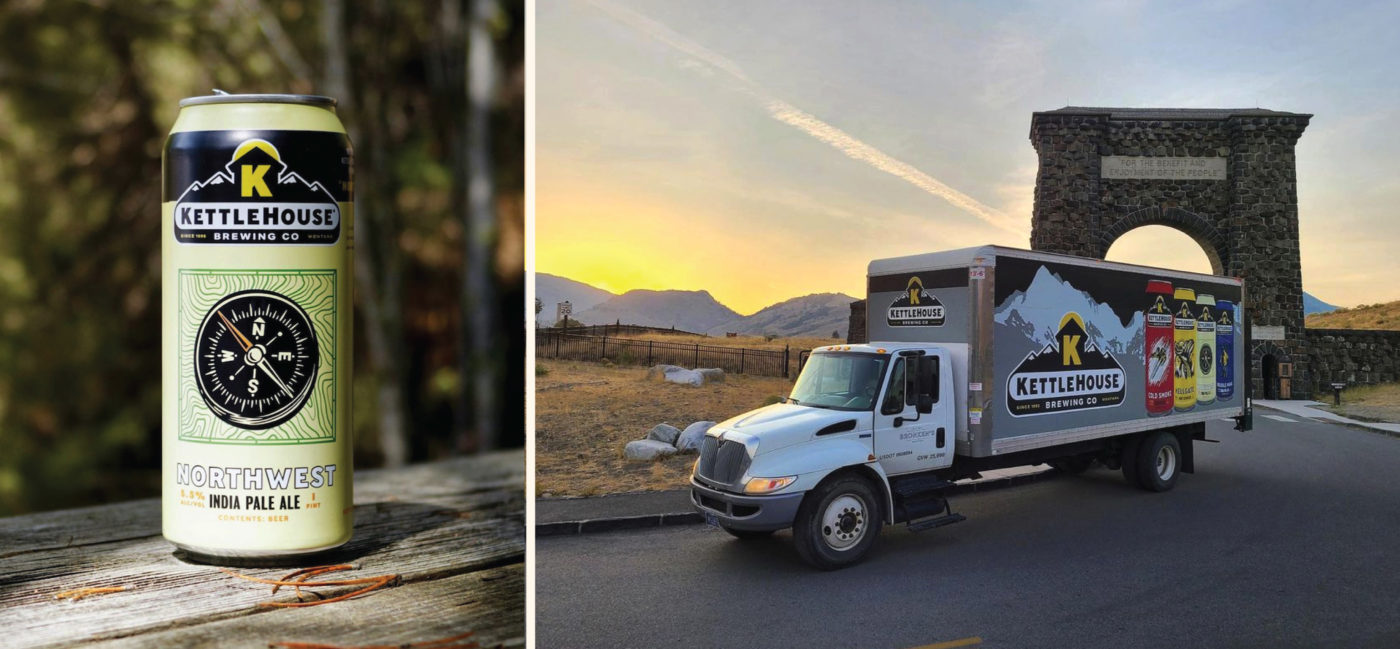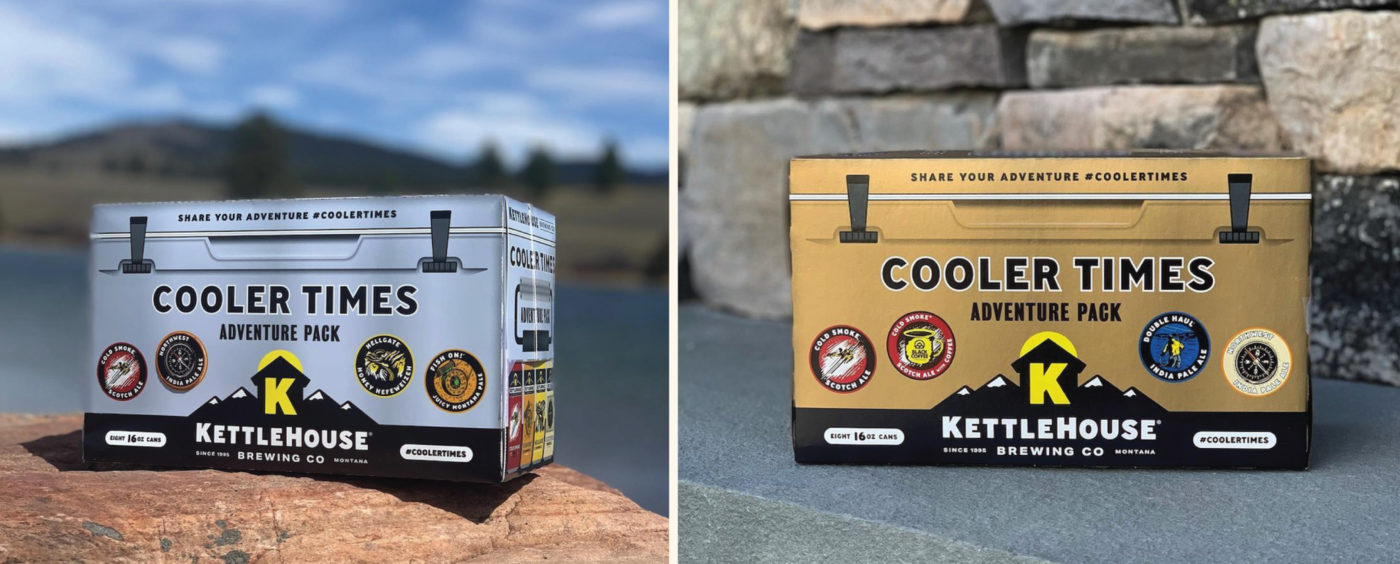***
A version of this conversation appeared in our Beer Branding Trends Newsletter. Subscribe for monthly tips on how to make better branding decisions and sell more beer.
***
Stories
Talking Shop with KettleHouse Brewing
What does business look like a few years after their rebrand
KettleHouse Brewing is a Montana staple. And we didn’t realize just how popular the brewery is until we posted a photo of Cold Smoke (the best selling craft beer in Montana) to our Instagram page. Comments started pouring in from people all over the country. “Cold Smoke!” “Bring me some!” “I love KettleHouse!”
We were fortunate to partner with KettleHouse for its rebrand back in 2019—the first “real” branding move the brewery had made in its 23 year history. KettleHouse’s (very) vocal fans were happy with the change. So long as Cold Smoke still tasted the same.
We caught up with the KH team—Suzy Rizza, Co-founder, Erin Parchert, Sales Manager andTiffany Lutke, Marketing Manager—to discuss life a few years out from the big change as well as how their team weathered the pandemic and what to expect from KettleHouse in the future.


You were doing a lot of things right for a lot of years before considering a rebrand. When we kicked off that process, there was even a question of how much we should update vs how much we should retain because your sales numbers were so good. Now that the dust has settled, are you happy you went through the rebranding process?
 Suzy
Suzy
Yes, I’m happy we went through it. For me, it was partly about feeling proud of our branding and partly about feeling competitive. As we grew and were talking about expanding to other markets, I wanted us to be competitive with other brands and not have outdated graphics. I also wanted to feel proud to see our set on the shelves. (not that I didn’t before, but…)
 Erin
Erin
I’m pleased with the way that the refresh helped our packages to block better on the shelves. We were lacking cohesiveness and consistency in our packaging prior to the refresh, and the refresh really did modernize our look and made KettleHouse as a brand/brewery stand in the forefront of our packaging.

How did your fans receive the updated look?
 Erin
Erin
It seems that we kept our graphics similar enough to not confuse people or make them nostalgic for what once was. The feedback has been very positive across social media and from our distributors.

Did you run into any issues as you fully transitioned to the new branding and packaging?
 ERIN
ERIN
There are always issues of packaging inventory when transitioning and this was no exception. We did a rolling transition, so it wasn’t as clean on the shelves in the short term, but we were able to fully utilize our old packaging and not have waste in that regard.
 Tiffany
Tiffany
Since the brand has been established for so long (25 years), many accounts had old logo files saved for advertisement in their bars and restaurants. It’s taking some time to make sure accounts are always using the new logo if they are creating a flyer or a post on social media. It is realistic that a handful of vintage logo LEDs and tin tackers will remain out in the market through the years, but our team and wholesale partners have been on top of replacing old tap handle stickers, providing updated POS and POP, and we’ve also established a page on Brandfolder, a digital asset management website, so we can easily provide a link to all updated assets for anyone who might need it. There are many vintage logo wearables out in the world as well, so we’ve also made sure to compliment the new beer packaging with plenty of updated merchandise to help showcase the new logos.

Build a stronger brand.
Sell more beer.
Join 7,500+ other beer industry folks and sign up for our monthly Beer Branding Trends Newsletter.

Beer Branding Trends 2.0

It’s common for breweries in a geographic region to brand and position themselves similarly. It’s not so much a me-too phenomenon as it is that everyone is likely there for a similar reason—skiing, fishing, hiking, etc. We saw that same situation in Montana (most breweries are centered around mountains and the outdoors). How has KettleHouse continued to position itself as Montana’s brewery?
 Suzy
Suzy
We have time and Cold Smoke® on our side. Having opened in 1995, we were one of the first breweries in the modern day craft beer environment – we position ourselves as the first modern brewery in Montana to can. We also brew Montana’s #1 selling craft beer (Cold Smoke®). The founder/owner of the business was born and raised in Montana and is passionately defensive of the Montana way of life. We make it a point to protect the things that make Montana great – clean water, public lands, and unparalleled outdoor experiences.
 Tiffany
Tiffany
Cold Smoke is the iconic beer of Montana, and KettleHouse is a household name among locals. According to Google, Cold Smoke is the #1 searched for craft beer by Montanans. For many people, Cold Smoke was their first craft beer, and a visit to our original taproom was their first taproom experience. KettleHouse cans are often a go-to for outdoor adventures. We encourage our fans to tag us in their post-adventure photos on social media, use our hashtags, and we share their photos on our own page as well. We partner with businesses and non-profit groups that align with our brand because it is what we enjoy, but it also strengthens our presence in Montana’s outdoor active world.
Additionally, the KettleHouse Amphitheater (managed by Logjam Presents) has become Montana’s premier music venue and is located on premise at our Bonner brewery- having access to amazing live music on the banks of the Blackfoot River gives residents and tourists another reason to love this state. In the next year, the Missoula Airport will launch the KettleHouse Tap and Grill and the Cold Smoke Tavern located post-security, which will allow us to give locals and tourists a proper Montana sendoff on their travels.

Bong Water has a charming, old school craft beer story (run in with the feds because you brewed the beer with—gasp—hemp). Several years later, and you’re updating the style but keeping the name. Tell us why?
 Suzy
Suzy
It’s a nod to our roots, to our early days, to our demographic. Back in the day, any affiliation with the “pot” industry was still very much an underground subject. The folks that vocally supported us when the feds were sniffing around were proud to see a business thumbing their nose at big government. Now, with it becoming more and more common for marijuana to be legal (yes, we know there’s a difference between hemp and marijuana), it’s almost come full circle and means something completely different now. It’ll be interesting to see how the meaning of it evolves as this fledgling industry evolves.
 Tiffany
Tiffany
When I first started working at KettleHouse, I learned that the original taproom, the Myrtle St. Taphouse, is lovingly referred to by locals as “the K-Hole”. As an outsider, and a marketer, my initial reaction was, “..Is that a name we should encourage?” But after living and working here for a while, I got it. Everyone loves the K-Hole, it’s the neighborhood watering hole, it’s been there forever, and locals wouldn’t change it for anything. Seriously, don’t try changing out the stools. The same goes for Fresh Bongwater. It would be a mistake to change the name of something that’s so well-loved. The brewery may have gotten bigger and the branding may have gotten an update, but Fresh Bongwater is a quirky reminder that even after all this time, we’re still the K-Hole. If we changed the name, yes, we could get it legally approved to distribute across state lines, but we’ve made a conscious decision to keep the name, and keep this beer Montana Only. The floral, hoppy aromas and flavors in the beer are reminiscent of fresh herb, so with the refreshed packaging design, we are making an effort to emphasize the “Fresh” part a little more on the can, but the “Bongwater” isn’t going anywhere. And as Montana recently voted for its legalization, neither is marijuana or an appreciation for the reference. We’re excited to take it to the next level with a brand refresh.

We had a lot of fun working on your Cooler Times mixed pack. We’ve seen mixed packs as a major brewery trend over the last few years—what were you hearing that made you want to create one? And how has it been received thus far?
 Suzy
Suzy
For us, it was an attempt to “introduce” our customers to more of our brands. Some beer drinkers can get in a rut and they like what they like and they buy the same thing over and over. With a mixed pack, there’s less of a risk to the customer – they don’t have to invest in a 4-pack or 8-pack of something they’ve never tasted and aren’t sure they’re going to like. With a mixed pack, we throw in a fan favorite, and then some of our new stuff. I think it’s easier for the customer to make the decision that way to try something new, and we get our newer beers into more hands. It’s a win-win.
 Tiffany
Tiffany
We always appreciate the insight our wholesale partners provide, and a mixed pack is something they were definitely interested in seeing from us. We are also aware that many people who travel to Montana know they want to try Cold Smoke while they’re here, and we wanted to give those customers a chance to taste some of our other brands as well, without having to commit to buying multiple varieties. We introduced a seasonal into the mixed pack to offer current fans a way to try out something new, but still provide them with their long-time favorites alongside it.
 Erin
Erin
We have a robust tourism market in Montana, and most folks who travel here have heard of, and want to try, Cold Smoke Scotch Ale. A mix pack allows for them to grab those Cold Smokes, but also to try some other styles from us that we may not be known for.

What challenges do you run into as a mid-market, 25 year old (!!!) brewery? Are there any issues that are unique to a brewery of your size and age or are they the same problem smaller breweries deal with, just on a larger scale?
 Suzy
Suzy
I’ll add to the question “what’s unique about the culture of the community that you’re in”. My friend was recently at a bonfire and someone was talking about when they first came to Missoula and they went to KettleHouse. They added “That was back when it was small.” That’s our biggest challenge as we’ve grown. How do you stay the hometown favorite while you grow? I can’t say for sure, but I think one thing that’s unique to Missoula is its hyper-local centrism. It’s something that makes Missoula absolutely special and the most supportive community a small business could ask for. It also makes it easier to “dash” people’s expectations of what you are to them. We’re a 15,000 bbl/year brewery. Nationally, microbreweries are classified as producing 0-15,000bbl/year and regional breweries produce between 15,000 and 6 million bbls. Technically, we’re a regional brewery, but we’re one hair’s width above 15,000. But the local perception is that we’re “big.”

We’re currently revamping your website. We’ve seen an uptick in breweries wanting newer, better functioning sites. What role does your site play in your business and marketing strategy?
 Suzy
Suzy
For us, a website is just part of the overall marketing toolbox, and our website hasn’t been as functional as it certainly could be. We currently don’t sell any merchandise online. In the Covid era! It’s unthinkable. And it seems that technology just keeps getting better and better – you can easily have functionality now that puts you in better touch with your customers, garners more customer data, and allows you to be very responsive to what’s going on seasonally or in your community by changing the marketing message every day if that’s what you want.
 Tiffany
Tiffany
Currently, while our site is under construction, we are driving more traffic to our social media channels for digital interactions, company update, and info. Moving forward, having a functioning and informative website where our customers can stay updated on all things KettleHouse, shop at our online store, find out where to buy our beer, and learn about our taprooms is particularly important during the global pandemic we are experiencing. With capacity limitations in public spaces limiting our taproom interactions, we are doubling down our efforts to continue to communicate and engage with our fans in the digital space.

How has KettleHouse weathered the Covid pandemic thus far? Do you have any pieces of advice that would be beneficial for other breweries to hear right now?
 Suzy
Suzy
As we’ve grown, and we’ve developed relationships with our lenders, accountants, and attorneys, we would talk about various business scenarios. We always used this phrase when describing the worst-case scenario and it was “if a meteor hit the earth.” It was a way of saying “OK, we can’t let that happen” but also a little bit of “but that would never happen” (so we’ll be OK). The meteor happened and it was called Covid. We spent the first few weeks of lockdown in March on the phone with our bank. They were nothing short of amazing. Shout out to Bank of Montana! We nervously asked if there was any way we could defer some payments for a while and their response was essentially, “Of course. Whatever you need.” My husband and I just sat in silence for five minutes with tears in our eyes. This pandemic has really stressed to us the importance of building those solid relationships with your business team – those resources you turn to when you need help. In 25 years, we have never missed a loan payment, never missed a payroll. We believe good, honest, two-way relationships are important and our time investment in building those relationships paid off. Also, thank god for diversification. The 2nd half of March, our taprooms were down 100% and our off-premise sales were up 100%. I really feel for all the businesses right now that rely on people’s physical presence.
 Tiffany
Tiffany
KettleHouse had to make the unfortunate decision of closing one of our three taprooms permanently. This was exceptionally difficult for our company and for our community. The capacity restrictions in taprooms along with our priority for providing a safe environment have changed the pace of our retail business. Our wholesale business has had more success during this challenging time. It’s been a priority for us to make sure we’re adaptable and always operating in the safest way possible. Advice would be to stay in communication with your fans and followers as much as possible.

If you had unlimited budget, what would you do / buy / invest in over the next year?
 Suzy
Suzy
Our BHAG (big, hairy, audacious goal) is to be carbon neutral. We’d invest in as much infrastructure that currently exists. Because we are In Search of Cooler Times™. 😊
 Tiffany
Tiffany
People, advertising, a pilot brewing system or three.

How important is story for the Montana beer drinker?
 Suzy
Suzy
I think story is important to every consumer of every product, whether they know it or not. In 2002, the Nobel Prize for economics was awarded to a psychology professor whose research proved that we behave emotionally first, rationally second. Stories create emotion.
 Tiffany
Tiffany
It’s extremely important. KettleHouse was co-founded by married couple Tim O’Leary and Suzy Rizza, who are still the current owners. The amount of engagement our social media posts receive anytime there is any content related to them, their families, or friends, is incredible. It doesn’t matter when the post is time stamped, it doesn’t matter if it has a filter, Montana beer drinkers appreciate our history and being part of it. They also enjoy sharing their own stories with our beer and from our taprooms with us, which we love. KettleHouse is something we all built together, and the stories around the beer help us all share in that.

What’s your grand vision for KettleHouse? And what can we expect to see from your team over the next year or two?
 Erin
Erin
It’s important for me in the sales realm that we continue to stay relevant with innovation, but also remind people that Cold Smoke is Montana’s favorite craft beer. Continuing to get out there every day and tell the story of KettleHouse, strengthening our position in Montana and the West has always been my goal for our team, and will continue to be.
 Suzy
Suzy
My grand vision is to pass this company on to the next “generation.” I’m so excited to see how its cared for and nurtured. I feel our team has really bonded and grown through the pandemic and I expect to see even better relationships and an environment that continues to encourage more creativity and innovation.
My grand vision is to pass this company on to the next “generation.” I’m so excited to see how its cared for and nurtured. I feel our team has really bonded and grown through the pandemic and I expect to see even better relationships and an environment that continues to encourage more creativity and innovation.

Build a stronger brand.
Sell more beer.
Join 7,500+ other beer industry folks and sign up for our monthly Beer Branding Trends Newsletter.



